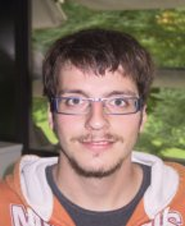Reversibly tethering growth factors to surfaces:
Guiding cell function at the cell-material interface.
Promotion date: January 31.
Promotor: Prof.dr. Jurriaan Huskens
Assistant Promotor: Dr.ir. Pascal Jonkheijm
| Development of novel methodologies for tethering growth factors (GFs) to materials is highly desired, for the generation of biomaterials with improved tissue repair properties. Progress in the development of biomaterials that incorporate GFs and the in vivo performance of such biomaterials in tissue engineering applications - such as stents, orthopaedic implants, sutures and contact lenses - is still challenged by the required control over the mobility of growth factors in biomaterials. This thesis is about the functional tethering of GFs to biomaterials using reversible chemical strategies with spatiotemporal control: a) non-covalent strategies to capture GFs to surfaces by employing nanobodies and peptides; b) reversible covalent chemistry to control the spatiotemporal availability of GFs in the extracellular matrix (ECM); and c) a protein array technology has been introduced to create functional platforms of various shapes and content for studying cell behavior. The reversibility of the tether has been found to play important roles in biological activity. The results demonstrate the advantage of tethers that combine immobilized GFs, such as GF stability or the creation of locally highly concentrated GF reservoirs, with released mobile GFs, such as optimization of orientation for an optimal interaction with cellular receptors. Although such systems are attractive, knowledge about the application of such tethering strategies in vivo is limited and deserves detailed attention in future research. For example, stimuli responsive systems might provide tools for a breakthrough in the tissue engineering field. |
Was your research oriented towards applications?
The application chances motivated me greatly, right from the start. Several contributors were involved, like Biomedical Materials - which is a research program including different projects in the field of regenerative medicine - and also two renowned hospitals: UMC Utrecht and Erasmus MC, as well as companies in the field of drug delivery materials and orthopaedics such as: InGell, Percuros, Innocore Pharmaceuticals or CellCoTec.
Immobilizing proteins is a main challenge in future strategies for growing implants and regenerative tissues in a way that prevents infections or rejecting bodily reactions. For example in repairing bone structures and cartilage regeneration, the findings of research can be of great use. When immobilization is effectively possible, body cells can signal surrounding body cells to actively produce new curing cells. Carrying agents could be: glass, gold or polymer materials. The supramolecular reversible approach is relatively new.
Was there an important moment during your thesis project that you recall very well?
1,5 years in my PhD period, I was able to show that cells were actually responding to my surfaces. Until then I was, more or less, playing around. Mesa+ always gave me total freedom in trying to find new strategies and new topics of research.
After this moment, I was able to modify the surfaces and differentiate in growth factors from them. Also, I was able to describe a new strategy to immobilize growth factors in a reversible manner.
Did you collaborate with various groups on this research topic?
Apart from Mesa+ groups researchers from the Mira institute, here in Twente, were involved too. It was very time saving to be able to talk to skilled researchers near your own working place, making use of the great facilities Mesa+ and Mira have to offer. For seeding cells on my surfaces the expertise of Mira was needed very much so. I learned a great variety of new techniques from these experts. I guess, the work that I was able to perform in one year now, would have lasted four years when working in a different environment.
What are your future plans now?
I would like to work for some years in industry now. My future career is not in academic research, I guess. Very often the research planning is centred around publishing academic results, more than on finding real solutions for people in need. In industry it will be clearer to be able to see who will eventually benefit from the work as a researcher, I suppose.
What, in your opinion, is important for Mesa+ to stay successful in future?
Now Mesa+ is more multidisciplinary as it was four years ago. Therefore I’d suggest MESA+ to collaborate with other research institutes in order to enhance the quality of the research.
The open atmosphere is special. Colleagues always trying to stimulate you in your research efforts. The access to facilities is world famous, of course. That is a great forte. It keeps you going on in research in a great way. The doors towards specialists from other institutions are open because of the worldwide reputation Mesa+ is happy to have.

